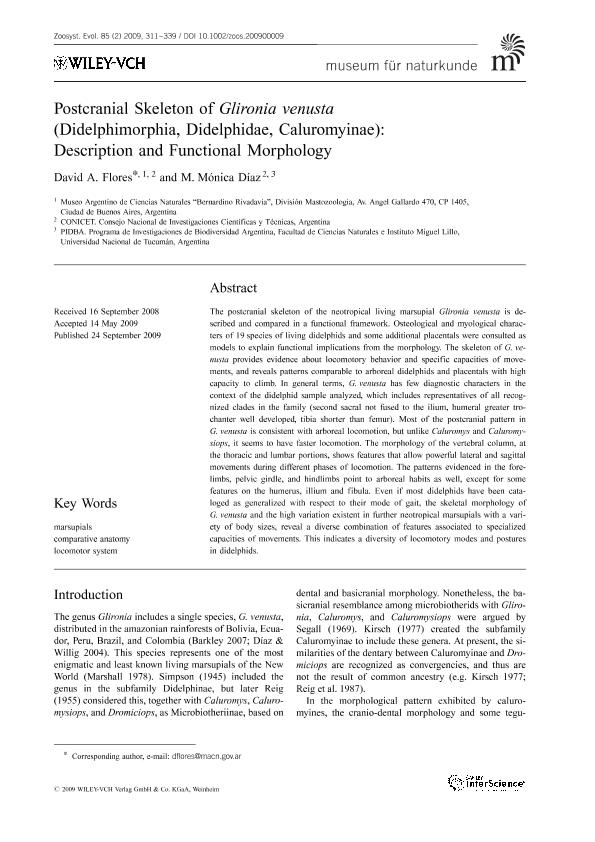Mostrar el registro sencillo del ítem
dc.contributor.author
Flores, David Alfredo

dc.contributor.author
Flores, David Alfredo

dc.date.available
2019-04-26T20:55:53Z
dc.date.issued
2009-09
dc.identifier.citation
Flores, David Alfredo; Flores, David Alfredo; Postcranial Skeleton of Glironia venusta (Didelphimorphia, Didelphidae, Caluromyinae): Description and Functional Morphology; Wiley VCH Verlag; Zoosystematics and Evolution; 85; 2; 9-2009; 311-339
dc.identifier.issn
1435-1935
dc.identifier.uri
http://hdl.handle.net/11336/75169
dc.description.abstract
The postcranial skeleton of the neotropical living marsupial Glironia venusta is described and compared in a functional framework. Osteological and myological characters of 19 species of living didelphids and some additional placentals were consulted as models to explain functional implications from the morphology. The skeleton of G. venusta provides evidence about locomotory behavior and specific capacities of movements, and reveals patterns comparable to arboreal didelphids and placentals with high capacity to climb. In general terms, G. venusta has few diagnostic characters in the context of the didelphid sample analyzed, which includes representatives of all recognized clades in the family (second sacral not fused to the ilium, humeral greater trochanter well developed, tibia shorter than femur). Most of the postcranial pattern in G. venusta is consistent with arboreal locomotion, but unlike Caluromys and Caluromysiops, it seems to have faster locomotion. The morphology of the vertebral column, at the thoracic and lumbar portions, shows features that allow powerful lateral and sagittal movements during different phases of locomotion. The patterns evidenced in the forelimbs, pelvic girdle, and hindlimbs point to arboreal habits as well, except for some features on the humerus, illium and fibula. Even if most didelphids have been cataloged as generalized with respect to their mode of gait, the skeletal morphology of G. venusta and the high variation existent in further neotropical marsupials with a variety of body sizes, reveal a diverse combination of features associated to specialized capacities of movements. This indicates a diversity of locomotory modes and postures in didelphids.
dc.format
application/pdf
dc.language.iso
eng
dc.publisher
Wiley VCH Verlag

dc.rights
info:eu-repo/semantics/openAccess
dc.rights.uri
https://creativecommons.org/licenses/by/2.5/ar/
dc.subject
Comparative Anatomy
dc.subject
Locomotor System
dc.subject
Marsupials
dc.subject.classification
Otras Ciencias Biológicas

dc.subject.classification
Ciencias Biológicas

dc.subject.classification
CIENCIAS NATURALES Y EXACTAS

dc.title
Postcranial Skeleton of Glironia venusta (Didelphimorphia, Didelphidae, Caluromyinae): Description and Functional Morphology
dc.type
info:eu-repo/semantics/article
dc.type
info:ar-repo/semantics/artículo
dc.type
info:eu-repo/semantics/publishedVersion
dc.date.updated
2019-04-11T19:52:18Z
dc.identifier.eissn
1860-0743
dc.journal.volume
85
dc.journal.number
2
dc.journal.pagination
311-339
dc.journal.pais
Alemania

dc.journal.ciudad
Berlín
dc.description.fil
Fil: Flores, David Alfredo. Consejo Nacional de Investigaciones Científicas y Técnicas. Oficina de Coordinación Administrativa Parque Centenario. Museo Argentino de Ciencias Naturales “Bernardino Rivadavia”; Argentina
dc.description.fil
Fil: Flores, David Alfredo. Consejo Nacional de Investigaciones Científicas y Técnicas. Centro Científico Tecnológico - Tucumán. Unidad Ejecutora Lillo; Argentina. Universidad Nacional de Tucumán. Facultad de Ciencias Naturales e Instituto Miguel Lillo. Programa de Investigación de Biodiversidad Argentina; Argentina
dc.journal.title
Zoosystematics and Evolution
dc.relation.alternativeid
info:eu-repo/semantics/altIdentifier/url/https://onlinelibrary.wiley.com/doi/epdf/10.1002/zoos.200900009
dc.relation.alternativeid
info:eu-repo/semantics/altIdentifier/doi/https://doi.org/10.1002/zoos.200900009
Archivos asociados
